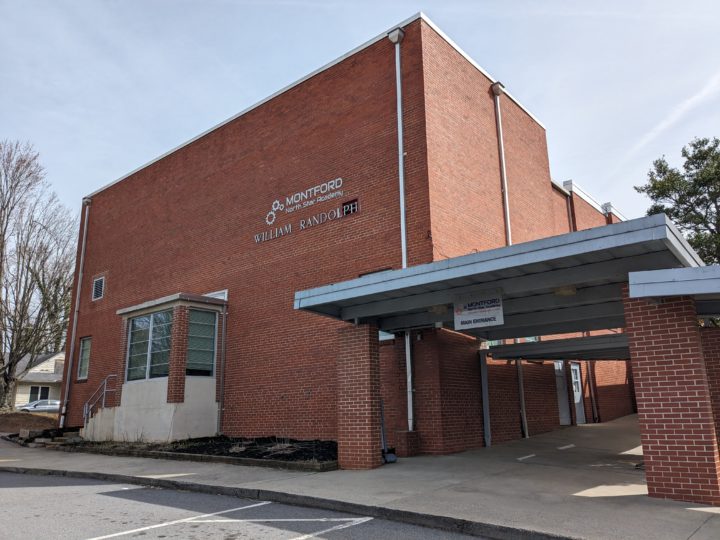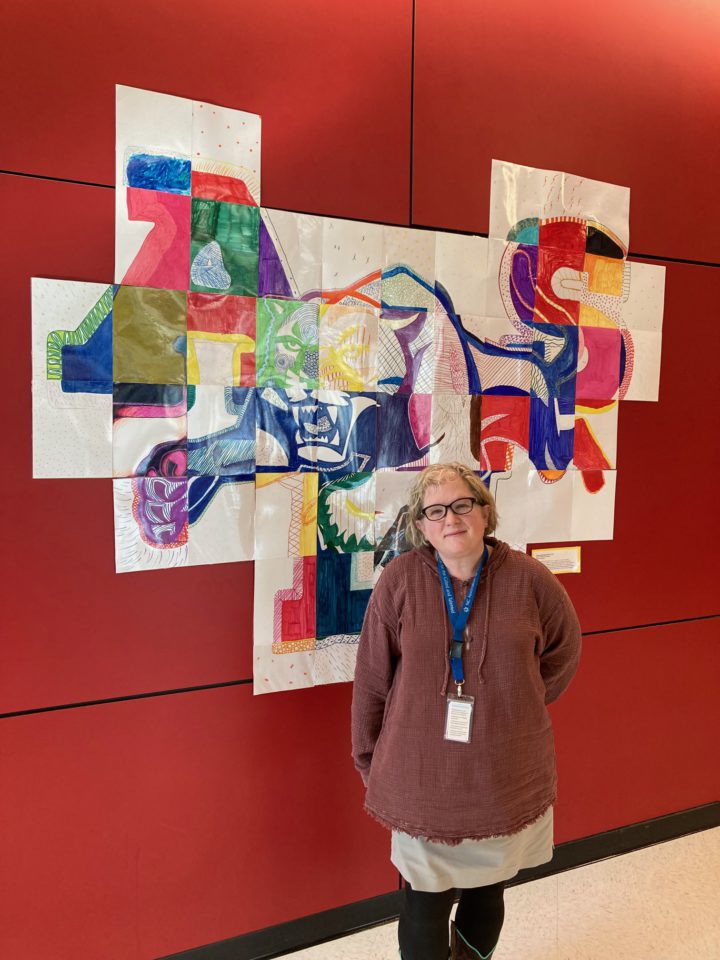The vinyl is skipping for Asheville City Schools. Just a little over two years removed from the controversial closing of Asheville Primary School, the Asheville City Board of Education is considering shuttering another parent favorite, Montford North Star Academy.
Residents are decrying a proposal that Superintendent Maggie Fehrman says could help the district address a projected $4.5 million budget shortfall next school year — merge its two middle schools. Fehrman estimated the merger would save the district $1.8 million to $2.3 million per year.
Fehrman is also looking for a new home for ACS’ alternative program, the Education and Career Academy, which is currently housed at the Housing Authority of the City of Asheville’s Arthur R. Edington Education and Career Center. Fehrman has identified the Montford campus as a potential permanent home for ECA.
Parents, students and staff packed two public meetings in late February to tell the school board to press pause on the decision, scheduled for Monday, March 11.
“Over and over again, I’m hearing from our community that this process does not make sense and it is moving too fast. It does not make sense to close down a school that is by all measures one of the most successful in the district. If the goal is to gain academic effectiveness, operational efficiency and long-term financial stability for ACS, dismantling MNSA will not accomplish these goals,” said Sarah Armstrong, parent and the school’s PTO president, at the second of two special board meetings Feb. 27.
Parents argue they haven’t had much time to review and comment on the middle school merger proposal, which was announced in November. Several parents said they didn’t become aware of the proposal until mid-January, when the district arranged a stakeholder meeting at nearby Isaac Dickson Elementary.
Additionally, some have said the district presented flawed data regarding MNSA’s capacity at initial meetings, inflating the amount of unused space at the middle school’s building, originally built as an elementary school in 1952. At the February meeting, Fehrman clarified the situation.
The district’s initially reported capacity for MNSA, 765, came from a facility study conducted more than a decade ago, when the school was the William Randolph Learning Center, Fehrman said. The N.C. Department of Public Instruction’s capacity number of 530 was also wrong because there are fewer rooms available at the school than was initially reported, she said. Fehrman now says the capacity is 442 for the school, meaning it is 49% full, based on its 2023-24 enrollment.
That new number puts MNSA closer to the rest of the district, including Asheville Middle School’s enrollment at 54% of capacity. The district’s five elementary schools vary from 50% to 71% full, according to district numbers.
Longtime MNSA Principal Shannon Baggett told Xpress she believes the school would be best served by capping enrollment at 80-90 per grade level, or 240-270 students, as leaders intended when the school opened seven years ago. They wanted to keep class sizes small to foster a greater sense of community within the school.
A capacity and enrollment study, approved by the board in November, isn’t likely to be completed until late March, Fehrman added, further fueling calls to slow the process down.
“We beg you to press pause until we have explored the impacts of every option on the table, including consolidating elementary schools, updating central office to once again be classified as a school and until an accurate capacity study has been completed and shared with the public,” Armstrong said.
Fehrman tells Xpress that March 11 is the deadline for the district to decide to move or close MNSA before the 2024-25 school year. If the board chooses to delay the vote, no major reconfigurations will happen next school year, she says. March 11 is also the deadline for open enrollment in ACS, when parents must apply for which school they would like to send their child to within the district.
Echoes of Asheville Primary
The debate about closing schools based on enrollment and capacity projections isn’t new for Asheville City Schools.

In its contested December 2021 vote to close Asheville Primary School, the school board, appointed by Asheville City Council at the time, cited the school’s lowest-in-the-district enrollment and $7.1 million in needed building renovations as reasons to shutter the K-3 school, which also had a preschool program. An enrollment study conducted that year by then-Superintendent Gene Freeman showed the school enrolled just 192 students, including pre-K and students in a Montessori program.
Today, MNSA has the lowest enrollment in the district, at 217, but advocates say that’s part of what makes the school special in an era where smaller schools are trendy, Armstrong says.
Courtney Shetley is one of many parents who say their child chose MNSA because of the culture that comes with a smaller environment.
“She liked the small class sizes there. She liked the feeling that everyone there was connected. I don’t want to say [it was a] family atmosphere, but everybody knew everybody, and the teachers were superinvolved. It just meshed better with her learning style to be in that small, more concentrated environment,” she says.
PTO President Armstrong, who used to teach at both MNSA and in a larger middle school in Buncombe County Schools, says that created a great environment for teachers also.
“I think that, in this small environment, not only do we build this amazing community for our students, but there’s a really fantastic teacher community built as well, because it’s so small,” she says.
APS had a similar allure for parents who sent their kids there. Its comparatively low enrollment compared with other district schools made it vulnerable, however, and the district discussed closing it for a year before it met its fate.
Many who were in Asheville in 2021 are drawing comparisons between the current conversation and the APS closure, which many parents have called “painful” and “traumatizing” for the students who lost their school.
“The Asheville City Schools Board of Education failed my family during the egregious closure of Asheville Primary School,” said Shifra Ahlers at the meeting. “When you closed Asheville Primary School, there were countless times that your feasibility studies provided incorrect information, including the capacity of the building, and the cost of running the school. Does this sound familiar to anybody? You have displaced hundreds of students. That was two years ago. Be very careful that you don’t do it again,” she said.
Some expressed despair that the district is doomed to repeat itself.
“To be honest, I’m feeling pretty hopeless about all this,” said Daniel deBettencourt, a parent who called the APS closure “terrible.”
“It feels like the central office has a plan, they know what’s going to happen, you guys are going to endorse that plan, and this is just sort of checking the box of community input. The plan will happen,” he told the board.
Board member Liza Kelly gave advocates a reason to maintain hope that the board hasn’t already made its decision when she made a motion to delay the conversation about closing or moving MNSA for two years, to raucous applause from the audience. The board was not prepared to take action at the special meeting, and the motion was not seconded.
Project-based learning
Parents, teachers and staff are proud of their Montford middle school, named a 2024 “School to Watch” by the N.C. Middle Level Educators Association. Of the more than 80 speakers who came to the February meetings, several student groups also spoke, pleading with the board to keep MNSA open, saying they appreciated the school’s smaller size, hands-on, project-based curriculum and emphasis on STEAM — science, technology, engineering, arts and math.
For example, this year, the school partnered with an Asheville trolley company to allow students to design and run a tour of youth-friendly things to do around the city, with different students leading presentations at different locations. Teachers integrated art and social studies on a field trip to Cherokee to learn basket weaving techniques and Cherokee history. The school has an “innovation lab” where students run an imitation TV studio.
The school also has an award-winning science olympiad team and is slated to compete in a state competition in April.
“So we’re not just connecting with the content here in school, but also with the real world; we’re collaborating with each other. We’re really big on collaboration and teamwork because we build relationships with each other by working together,” says Baggett.
Baggett was promoted in February to assistant superintendent of curriculum and instruction, a move she welcomes while acknowledging the timing is not ideal. She will continue to serve as principal at MNSA until an assistant principal is found to replace Miranda Wheeler, who will become principal, she said.
The school’s collaborative approach also contributes to the high satisfaction marks among its teachers.
In a statewide teacher working conditions survey, MNSA was one of six ACS schools to have 100% participation in the voluntary survey. For comparison, 25 of BCS’ 45 schools had 100% participation. According to the survey, 100% of Montford teachers either agreed or strongly agreed that Montford is a great place to work and learn.

Armstrong attributes that satisfaction to professional development opportunities and collaboration among the staff.
“Because project-based learning is so collaborative, it kind of forces you to get out of your classroom and be with your co-workers, and that creates a really pleasant, happy, productive working environment that directly benefits the students,” Armstrong says.
Matthew Leggat, who has been teaching language arts at MNSA since it opened in 2017, says the consistency in administration at the school has been instrumental in its success, something that hasn’t happened at the district level. ACS is on its seventh leader since 2013.
Baggett is also proud of the school’s spin on parent-teacher conferences. It is the students who lead the quarterly conferences, identifying their own strengths and weaknesses in front of their parents and teacher.
Daniel Shetley says it has been amazing to watch his daughter be able to recognize her growth and acknowledge her shortcomings in those meetings.
“They’re teaching her how to be a human being outside of the four walls of the school, which is what growth is all about, and what education is all about,” he says.
A different option
For most advocates, the mission to save MNSA is not a critique of Asheville Middle School.
In fact, AMS has its strengths, and several parents report sending a child to each school, depending on their needs. As a larger school, AMS has more athletic programs to offer, with facilities on campus. MNSA students are bused to AMS to participate in athletics. AMS also has a large band program that regularly wins awards, says Principal Jo Landreth.
The school utilizes the AVID program, which pairs certain students with UNC Asheville students who tutor them. The school has buildingwide, small-group meetings to discuss a book they’ve all read, sometimes as an entire school and sometimes by grade level, she added.
Landreth is particularly passionate about building community at AMS, bringing in the wider neighborhood to community nights to further engage parents and remind students how much fun they can have at school.
As the district works on an updated marketing campaign to help bolster its dwindling enrollment numbers, it is highlighting the choice parents have among its five distinct elementary schools and its two middle schools, an irony not missed by MNSA advocates.
“I find it very interesting that our big thing that we advertised about our district is choice. But we’re here talking about removing choice as the most difficult time in anyone’s life,” parent Kathryn Hardy remarked at the meeting. “Our superintendent has a lovely new message where we belong here. These actions do not show that the staff, students or families belong in this district. It is the antithesis of creating a sense of belonging.”
The school board will face its own choice March 11.




Just the flip side of nimbyism——-all for efficiency and wise use of taxpayer funds, just don’t change anything I care about.
Merge the Asheville and Buncombe schools for meaningful savings and removal of bureaucracy
Just playing devil’s advocate a bit, but when has it been shown in expenditures and actions that this version of local government has acted with “efficiency and wise use of taxpayer funds”? Just sayin’… How much trust should we show to decisions here?
This data Dr. Fehrman gives just doesn’t make sense. Three children (that I know of) from my child’s elementary school choose MNSA, did not get in for Fall 2022. If the school was so empty why weren’t they able to attend turned away? They were all great kids and deserved the chance to have a choice.
I find it interesting that the article’s last sentence is that the “school board will face its own choice.” What about the choice of the students and constituents? These people are supposed to represent everyone -their choices and perspectives don’t matter, they have to make the decision that will bring more kids into the district. Closure of this beloved school will make many elementary school families look elsewhere.
HA, ok…so then the empty building can be fast converted into illegal migrant housing, right ?
Schools, streets, sidewalks, parking garages, Malvern pool, Memorial Stadium, Thomas Wolfe auditorium, etc. are NOT priorities for the current city council and city manager. Yet, only about 30% of residents turned out to vote in the primary. If people want change, they need to get out and vote.
Here we go again. Pause, slow down, it is the wrong information. The facts are the facts. Merge the two districts. ACS is going to continue to go down. It is all about the rich white parents and what they want for their kids. No conversation of the gap between black and white students. I don’t think the board has the backbone to close the schools. Freeman was ripped for bringing eyes to the budget….just give it time the new superintendent will be pushed out to…